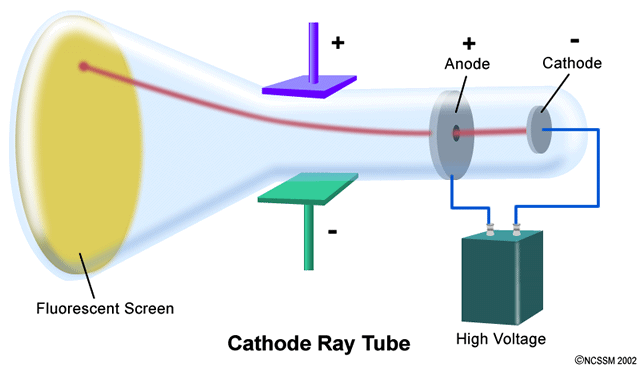
The activity sheet has embedded questions designed to promote small group discussions. The diagrams help students understand the significance of each experiment. The activity sheet has diagrams of each of the cathode ray tubes used in the demonstration. The prefix per- indicates one more ) atom than the oxyanion ending in -ate hypo- indicates one ) atom fewer than the oxyanion ending in -ite.Įx: ClO4^- = percholrate ion, ClO3^- = cholorate ion, ClO2^- = chlorite ion, ClO^- = hypochloriteģ) Anions derived by adding H+ to an oxyanion are named by adding as prefix the word hydrogen or dihydrogen. A class activity sheet accompanies the cathode ray tube demonstrations and experiments. Developed from the earlier Geissler tube, the Crookes tube consists of a partially evacuated glass bulb of various shapes, with two metal electrodes, the cathode and the anode, one at either end.
#Cathode ray experiment animation series
Prefixes are used when the series of oxyions of an element extedends to four memebers, halogens. A Crookes tube is an early experimental electrical discharge tube, with vacuum, invented by English physicist William Crookes and others around 1869-1875, in which cathode rays, streams of electrons, were discovered. The -ate is used for the most common or representative oxyanion of an element, -ite is used for oxyanion that has the same charge but a O atom fewer.Įx: NO3^- = nitriate ion NO2^- = nitrite ion A few poytomicĢ) Polytomic anions containing oxygen have names ending in either -ate or -ite and are called oxyanions. Thereby the electrons are supplied electric energy \( E_ \).1) The names of the monotomic anions are formed by repalcing the ending of the name of the element with ide.Įx: H- = Hydride ion, (O)^2- = Oxide ion.

The electrons are accelerated on the distance \( m \), from the thermionic cathode electrode to the ring anode by the acceleration voltage \( U_B \). These instruments are used in Radio stations for observing the transmitting & receiving properties of signals. The CRO is used to measure the current, frequency and voltage, etc.

The wehnelt cylinder takes care that the electron beam of the thermionic cathode electrode does not divert in all directions and as such misses the ring anode. The cathode ray oscilloscope is used to examine the signal properties, testing of oscillation distortion, signals frequency response, etc. The screen consists of material that produces light when hit by electrons. There they are directed towards to screen by the electric field of the capacitor and finally arrive at the screen. When the electrons passed the ring anode the move with constant velocity further to the capacitor. The very intense electric field that results from this accelerates the few ions present in the tube which, via collisions, ionize other particles. A high voltage (between 10 and 100 kV) is applied between two electrodes. A partial vacuum (less than 10 -6 atm) is maintained in the tube. These are accelerated by the acceleration voltage \( U_B \) towards the ring anode. Thomson’s second experiment involving the deviation of an electron beam in a vacuum tube, called a Crookes Tube. The thermionic cathode electrode is heated by the heating voltage \( U_H \) and emits electrons (thermionic emission). Thomson proposed that cathode rays were streams of particles much smaller than atoms.

This ushered in a model of atomic structure referred to as the plum pudding model. Dalton thought that atoms were indivisible particles, and Thomson's discovery of the electron proved the existence of subatomic particles. Non-Horizontally Launched Projectiles and their Trajectories Explanation: Thomson's experiments with cathode ray tubes helped him to discover the electron (which Dalton did not know about).


 0 kommentar(er)
0 kommentar(er)
